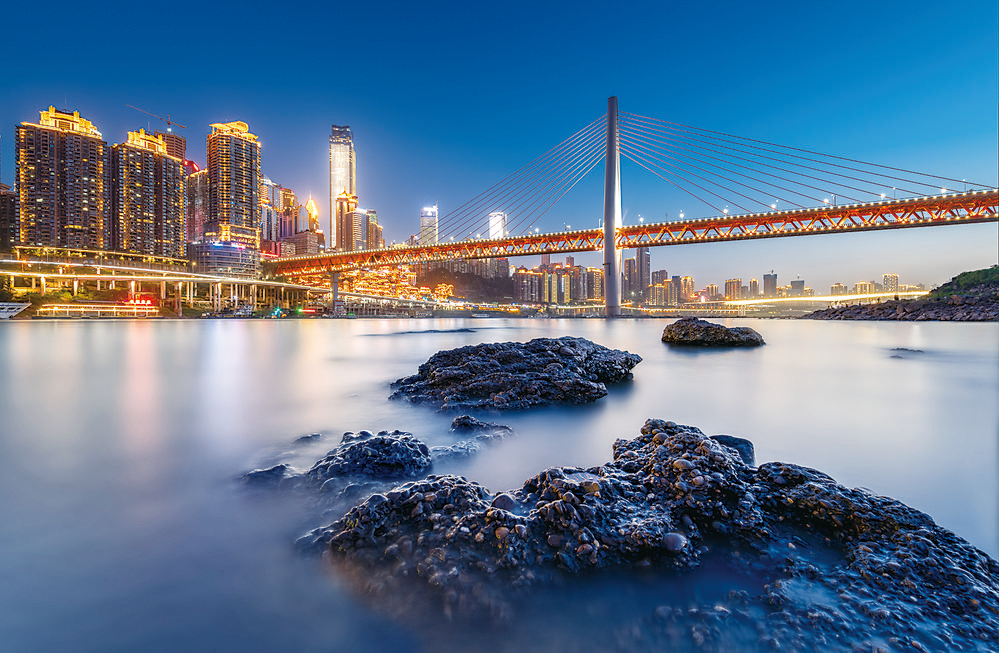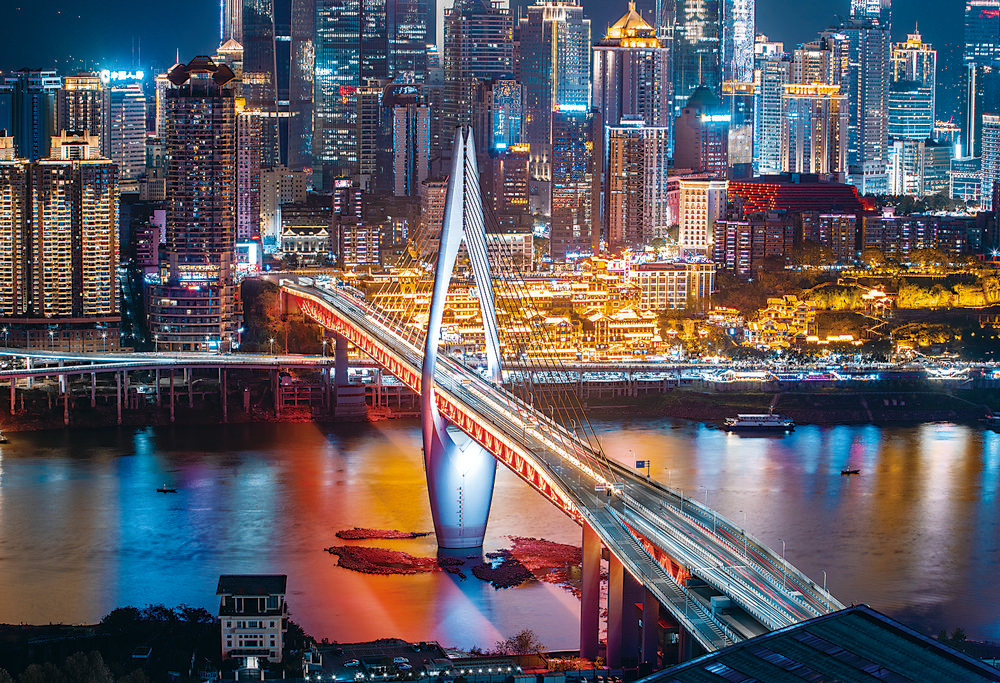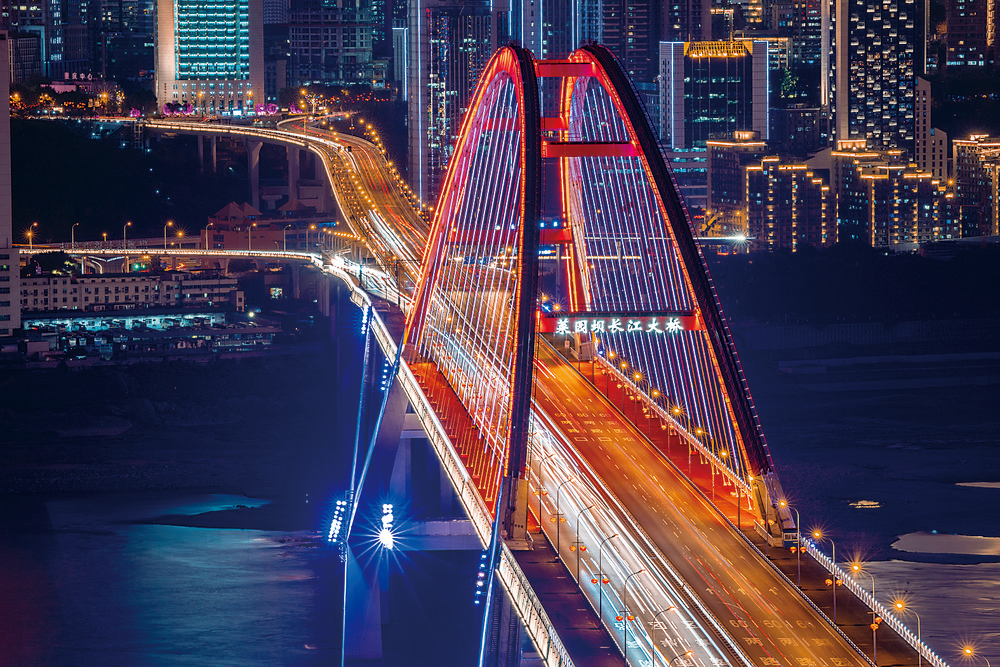Chongqing News
The story of bridges in Chongqing
2022-06-02 14:06:41



CHONGQING (CQNEWS) -- When the night falls, people are intoxicated by the beauty of Chongqing. In this stunning picture, the bridges of Chongqing are the permanent theme. These tridimensional bridges are pearls interspersing the beautiful night of Chongqing, attracting many tourists to come. Yet few people know why those bridges with various appearances can match the city so well.
How the city beautifies itself with bridges? Liu Xiaohui, the designer of Dongshuimen Bridge and Qiansimen Bridge, and the deputy chief engineer of CMCU Engineering Co., Ltd, will uncover the secret for us.
The designer of China’s first asymmetric arch bridge
In 1964, Liu was born in Longchang, Sichuan province. When he took the National College Entrance Examination, an idea came to him: since many cities in China were in poor transportation situations, perhaps I could be a student who majored in building bridges and roads!
In 1980, Liu was admitted to Chongqing Jiaotong Institution, which is now Chongqing Jiaotong University, and his major was the Bridges and Tunnels. After his graduation, he was assigned to the Research Institute of Highway Ministry of Communications for the design and research of bridges.
In 1987, he and his colleagues engaged themselves in a scientific research task named “The Design Construction Method of Asymmetric Arch Bridge” and built the first asymmetric arch bridge in China - the Tanmeichong Bridge, which earned him the third price of scientific and technological development issued by the Ministry of Communications.
This prize further piqued his interest in scientific research.
The innovative Caiyuanba Yangtze River Bridge
With the development of bridge construction in Chongqing, people laid emphasis not only on the function of bridges as transportation, but also on the design of bridges’ appearances.
At that time, the company where Liu worked won the bid for the Caiyuanba Yangtze River Bridge, and he was the designer of the bridge. “At that moment, Chongqing boasted E’gongyan Bridge as the representative of a suspension bridge, Huanghuayuan Bridge and the Shibanpo Yangtze River Bridge as the representatives of a steel beam bridge, as well as Shimen Bridge and Lijiatuo Bridge as the representatives of a cable-stayed bridge. Therefore, Chongqing people were looking forward to an arch bridge in terms of bridge type,” said Liu.
In 2003, as soon as Liu embarked on the designing of the bridge, he was faced with three challenges.
Firstly, if an arch bridge was needed, the height of water of the Yangtze River in the Chongqing section was too large. As a result, if a high pier was built to bear the horizontal thrust, it is neither economical nor reasonable. Secondly, how could they build a large bridge with a slim and transparent design? Thirdly, the most reasonable structure for a highway and light-railway bridge should be figured out.
Then Liu needed to address the problems one by one.
According to the official documents, a pair of c-concrete Y-shaped steel structure side spans support the trussed beam of Caiyuanba Yangtze River Bridge, which, combined with a mid-span and 320-meter steel box basket handle arch and tied arch, constitutes the structural system of the main bridge. This is for the first time adopted in China’s larger-span arch bridge. In this way, reasonable a short span structures are combined into a large-span structure. That is how a slim, eye-pleasing and innovative bridge is built. Compared with the concrete structure, the weight of the bridge is reduced by about 40,000 tons.
The “weight reduction” of the bridge helped Liu to build a slim and transparent bridge as expected.
In order to build a highway and light-railway bridge, Liu and his team, after profound consideration, decided to adopt an economical, aesthetic and innovative form – vehicles and trains run on the upper deck and lower deck respectively, which was an innovative way of design in China.
The major part of Chongqing’s night views
The completion of CRT Line 6 brought a challenge – the construction of the Dongshuimen Bridge and the Qiansimen Jialing River Bridge to the designers, both of which were also bridges for highway traffic and light-rail traffic. Designers from all over the world were interested in the construction of the bridges.
Now, when you look down from Yuzhong Peninsula, the two bridges are just like two arms stretching out from the peninsula, which are spectacular and elegant. “It looks like two bridges but it is actually a single large bridge. They can be twin bridges.” Liu and his team participated in the bid and won the design right with the concept.
Looking back, Liu revealed more details about the bridge. “First we needed to deal with the height of the bridge; that was, at what height can the bridge not destroy the beauty of the mountain line and skyline of the two rivers and four banks; then we had to consider the appearance of its piers – what design can make the bridge blend in the brightly-lit Chongqing?” On those days of designing, whether it was a sunny day or a rainy day, the team persist in observing the area around two rivers and four banks. Eventually, they decided to adopt water drop-shape and shuttle-shape piers to connect the two bridges, resulting in a unique landscape of two bridges and three towers. As such, the twin bridges become a highlight of Chongqing’s night views.
Liu and his team have made a breakthrough in the design of the cable-stayed bridge, so as to reduce the damage to the environment. He gave us an example: “The cables of other bridges are usually a pair every 8 meters, which is rather dense. But every cable of Dongshuimen Bridge is 16 meters long, which provides a better sight. Therefore, when vehicles pass through this bridge, passengers will have a clearer view through a window. ”
(Source: Chongqing Evening News; photos provided by Zhang Kunkun)
(Translated by Huang Ziming, Fathom Language Limited)
Editor:Jiang Yiwei
 手机阅读分享话题
手机阅读分享话题